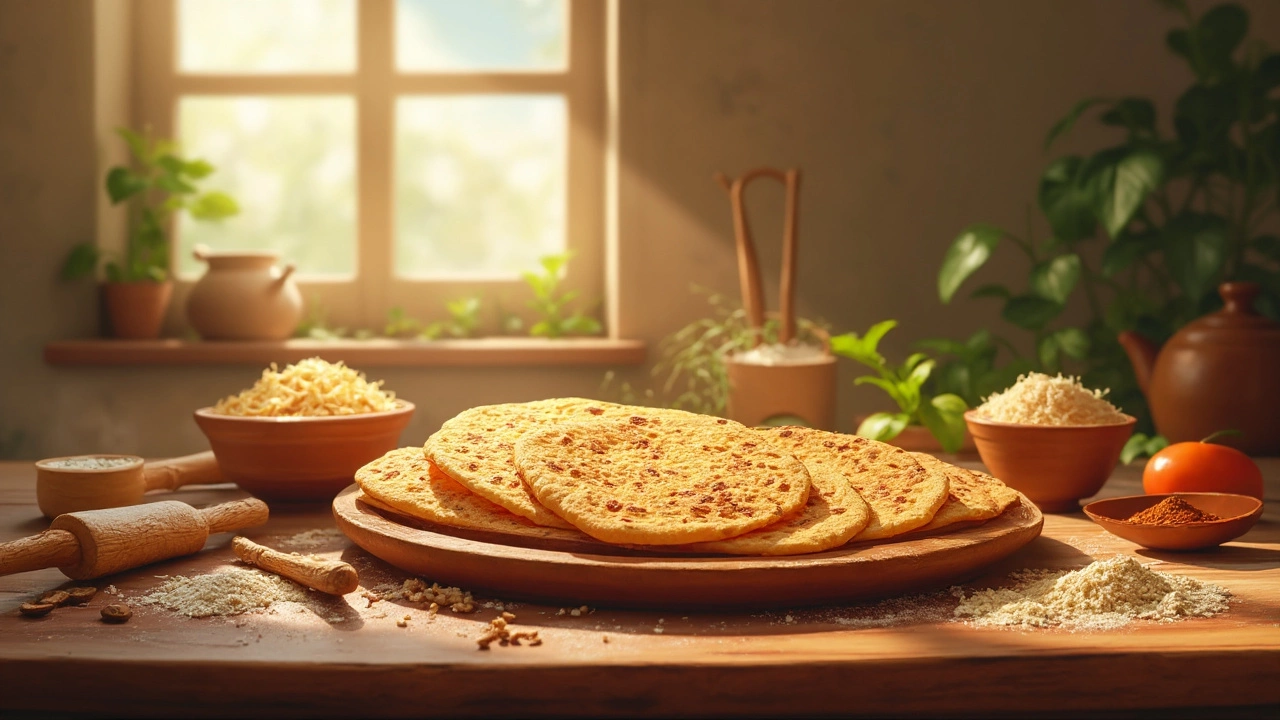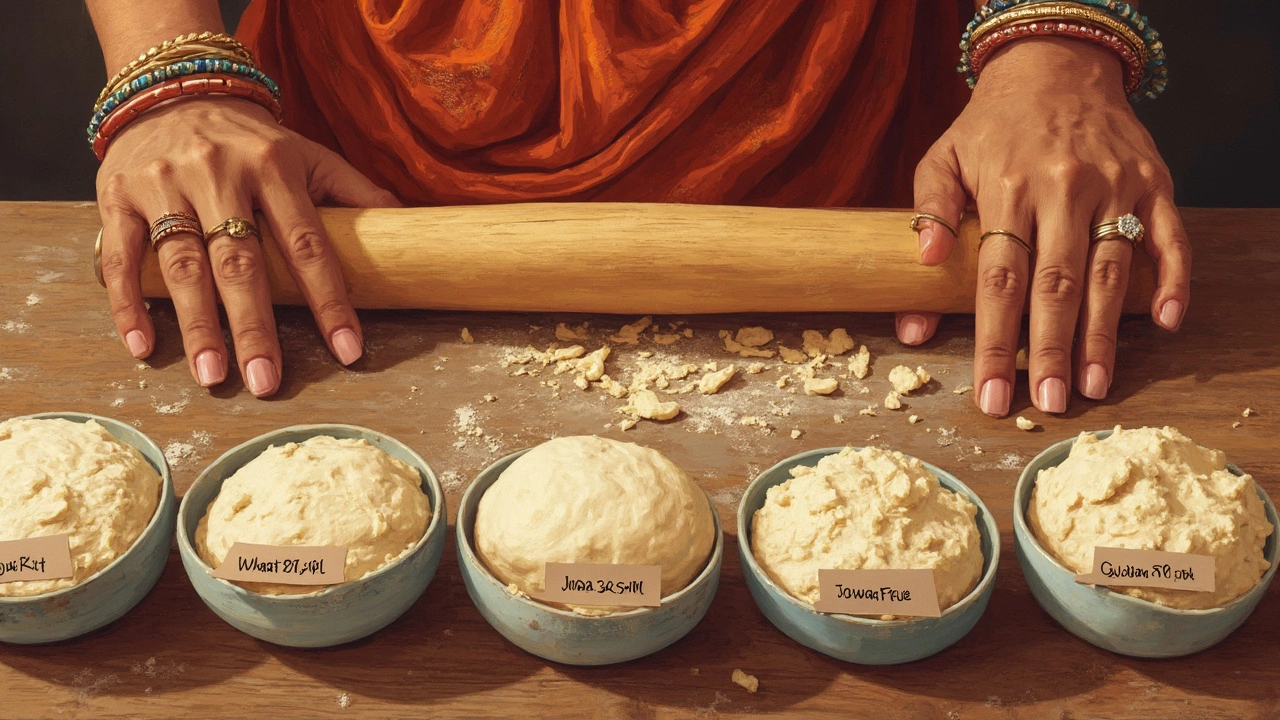Are Gluten-Free Rotis Lower in Calories?
 Feb, 22 2025
Feb, 22 2025
Rotis are a staple in many households, but how do gluten-free rotis compare to the regular ones when it comes to calories? If you're trying to figure out how much calories in 1 roti or even calories in 1 roti with ghee, you're not alone. Gluten-free doesn't automatically mean lower calories—sometimes it's quite the opposite!
Let’s break it down. A standard whole wheat roti packs around 70-100 calories, depending on the size and ingredients used. Add some ghee, and the calories in 1 roti with ghee easily climb up about 30-50 more calories. Meanwhile, gluten-free rotis often use almond, coconut, or other alternative flours, which can change the calorie game.
But don't worry! Choosing between gluten-free and regular rotis doesn't have to be a headache. Understanding your goals, whether it's managing gluten intolerance or mindful eating, is key. Stick around to figure out how many calories in 1 roti fit into your meal plan, discover some calorie-savvy substitutes for rotis, and get familiar with balancing calories in 1 roti and sabzi.
- Understanding Caloric Content of Rotis
- Gluten-Free Rotis vs. Regular Rotis
- Healthy Rotis and Complementary Dishes
- Smarter Eating: Tips and Tricks
Understanding Caloric Content of Rotis
All rotis aren’t created equal, especially when you peek at their calorie counts. Maybe you've found yourself pondering how much calories in 1 roti, or how to keep this number in check. Let’s demystify the calorie content of rotis, one bite at a time.
Calories in Regular Rotis
The standard roti made from whole wheat flour is a go-to in many kitchens. Typically, one such roti has around 70-100 calories. The calorie count isn’t just a random number off the shelf; it depends on several factors: the size of the roti, the type of flour used, and if you decide to slap on some ghee or oil during cooking.
Add a dollop of ghee, and the calories in 1 roti with ghee can jump by 30-50 calories. Delicious? Absolutely. But it's about making conscious, informed choices.
Calories in Gluten-Free Rotis
When gluten gets the boot, the calories in roti can vary quite a bit. Gluten-free versions often incorporate alternative flours like almond or coconut. Depending on the flour, this can either up the calorie count or surprisingly reduce it. For example, almond flour may raise the calorie amount due to its high-fat content, despite being gluten-free.
There’s a tendency to think gluten-free automatically means lower calorie, but let’s kick that myth right out the window. It’s about the individual ingredients.
How to Balance Your Calorie Count
So what’s the magic trick to enjoying rotis without overloading on calories? It's all about balance. Pair your roti with a low-calorie, high-fiber sabzi. Aim for a filling meal that doesn’t sneakily increase calories.
- Choose whole wheat or mixed flours for regular rotis.
- Opt for a gluten-free roti only if it suits your health needs.
- Check flour labels; awareness helps avoid high-calorie surprises.
- Remember, moderation is key! A roti or two won’t wreck your diet.
Understanding the calories in 1 roti and sabzi can help you plan meals better and stick to your fitness goals. Bon appétit, but mindfully!
Gluten-Free Rotis vs. Regular Rotis
The big question, are gluten-free rotis actually a lower-calorie option? It's not as straightforward as you'd think. While gluten-free diets cater to those with gluten intolerances, they aren't always the magic bullet for fewer calories.
Calorie Differences
Regular rotis, made from whole wheat, offer a great source of fiber and typically contain about 70-100 calories, but as soon as you slather on some ghee, those calories in 1 roti with ghee add up quickly. On the flip side, gluten-free rotis often use almond, coconut, or chickpea flour, which alters their nutritional profile.
While gluten-free options can be higher in protein and lower in carbs, they might pack more calories due to the nuts and oils present in almond and coconut flours. Here's a quick look at a general calorie comparison:
| Type of Roti | Calories |
|---|---|
| Regular Whole Wheat Roti | 70-100 |
| Gluten-Free Almond Roti | 120-150 |
| Gluten-Free Coconut Roti | 130-160 |
Choosing the Right Roti
Thinking about your nutritional needs makes choosing the right type of roti easier. If you're aiming for fewer calories, a simple whole wheat roti could be the answer. However, if your focus is on avoiding gluten, consider gluten-free options but be mindful of portion sizes.
- Find Balance: Pair your rotis with low-calorie sides like veggie curries to keep calories in 1 roti and sabzi manageable.
- Portion Control: Keep roti count lower if you're opting for higher-calorie gluten-free varieties.
At the end of the day, balance and moderation are key. Whether it's gluten-free or not, it's about matching your dietary goals and making conscious choices. Enjoy your rotis without guilt by knowing exactly how they fit into your meal plan!

Healthy Rotis and Complementary Dishes
Ever wondered how to make your rotis healthier while also complementing them with nutritious dishes? It’s pretty straightforward once you’ve got the right tips.
Choosing the Right Ingredients for Rotis
The base of any healthy meal starts with quality ingredients. When aiming for healthier rotis, consider using whole grain flours. They're rich in fiber and help in keeping you full longer, making them a better alternative to refined flours. Now, if you're looking for a gluten-free rotis option, explore flours like almond or chickpea. These not only support a gluten-free diet but are also packed with protein.
"Whole grains and high-fiber foods help reduce the risk of heart disease," according to Dr. Ann Kulze, a renowned nutrition expert.
Pairing Rotis with Nutritious Side Dishes
It's not just about the calories in 1 roti, but also what you serve them with. Pair your rotis with a bowl of mixed vegetable sabzi. A diverse range of veggies not only adds color but boosts nutrient intake. Soups and dals are excellent choices as they are low in calories and high in proteins.
If you prefer non-vegetarian options, grilled chicken or fish serve as great protein-rich sides. Balance is the key, so try to include a variety of nutrients in your meals.
Healthy Tips for Cooking Rotis
- Use less oil: Stick to using minimal oil and skip the ghee if you're watching calories.
- Portion control: Keep an eye on portion sizes. Instead of one big roti, opt for two smaller ones to trick your brain into feeling fuller.
- Storing smartly: Make rotis in bulk and freeze them for meal prep. This helps in reducing cooking time without sacrificing nutrition.
Combining these ingredients the right way keeps you on track to a balanced diet. Comparing the calories in 1 roti and sabzi can seem daunting, but it gets a lot easier once you start including more veggies and fibrous ingredients into your meals.
Smarter Eating: Tips and Tricks
Eating smarter isn't about saying goodbye to delicious rotis, it's more about making smarter choices. Let’s get into some easy tips that can help you enjoy your meals while keeping an eye on those calories.
Understanding Your Ingredients
Not all gluten-free rotis are created equal. They often use alternative flours like almond or chickpea, which can affect how much calories in 1 roti you'll end up with. Almond flour adds some healthy fats and proteins, but the calorie count can be higher. It's a trade-off worth noting.
Customize Your Portion Sizes
Keeping tabs on serving size can make a huge difference. Instead of having a uniform size for every meal, tailor it to complement the rest of your diet. Here’s a quick way to do it:
- Use palm size to gauge your main food portion like rotis. This is especially handy for homemade options.
- If adding ghee, a teaspoon is enough to get the flavor without overloading on calories.
Balance with Side Dishes
Pairing your gluten-free rotis with nutrient-dense sabzi can amp up your meal's nutritional value while keeping the calorie count in check. A good rule? More veggies, fewer grains. This keeps calories in 1 roti and sabzi on the lower side while still satisfying.
Simple Cooking Tricks
- Use non-stick pans to reduce the amount of oil needed for cooking rotis.
- Opt for steaming or grilling veggies instead of frying. It keeps the calories lower while enhancing flavors through simple herbs and spices.
Quick Nutritional checks
Why not create a small table to double-check your nutrition goals occasionally? Here's a quick reference for calories:
| Food Item | Calories |
|---|---|
| Whole Wheat Roti | 70-100 |
| Gluten-Free Roti | 90-110 |
| Ghee Addition | 30-50 |
| Veggie Sabzi | 50-80 |
By making these small adjustments in your daily habits, you can enjoy the taste and flexibility without losing focus on those wellness goals!